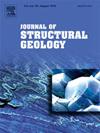The influence of kinematics of deformation on polycrystalline halite dynamic recrystallization: Full-field simulation of simple shear versus pure shear
IF 2.9
2区 地球科学
Q2 GEOSCIENCES, MULTIDISCIPLINARY
引用次数: 0
Abstract
Rock salt, composed mainly of halite, flows viscoplastically over a wide range of geological conditions, strongly impacting the dynamic evolution of sedimentary basins and orogens. Understanding how dislocation creep, which involves dislocation glide, intracrystalline recovery and dynamic recrystallization, influences the microstructure and rheology of halite under various deformation kinematics and temperatures is crucial for enhancing knowledge of salt flow dynamics. This study employs a full-field numerical simulation method to compare the viscoplastic deformation of polycrystalline halite under simple shear and pure shear conditions up to a natural strain of ε = 1.5 at temperatures ranging from 100 °C to 300 °C. The results are presented in terms of crystallographic preferred orientation (CPO), grain shape preferred orientation (SPO), subgrain boundary direction, grain size and strain rate distribution. The results indicate that the crystallographic anisotropy of individual halite crystals is transferred to the polycrystalline scale, resulting in strain localization, particularly in simple shear simulations. The kinematics of deformation affect the evolution and distribution of high strain-rate bands, determining the direction of intragranular substructures and the morphology of strain-induced grain boundaries, with minimal impact on grain size. The intensity of grain boundary migration increases with temperature, significantly influencing grain morphology and size, thereby obscuring strain localization, while having little effect on CPOs. At low strain (ε < 1.0), CPOs relative to both the maximum shortening direction and the grain SPO are similar regardless of the deformation kinematics. At high strain (ε > 1.0), simple shear CPOs exhibit three stronger {100} maxima with a monoclinic symmetry relative to the grain SPO compared to the six {100} maxima with an orthotropic symmetry relative to the grain SPO generated under pure shear. Therefore, microstructures and CPOs can serve as indicators of the strain path in polycrystalline halite under various conditions, aiding in determining the shear sense and elucidating the deformation kinematics of salt structures.
变形运动学对多晶岩盐动态再结晶的影响:单纯剪切与纯剪切的全场模拟
岩盐主要由岩盐组成,在各种地质条件下具有粘塑性流动,强烈影响沉积盆地和造山带的动力演化。了解位错蠕变(包括位错滑动、晶内恢复和动态再结晶)在不同变形运动学和温度下如何影响岩盐的微观结构和流变学,对于提高盐流动力学知识至关重要。本研究采用全场数值模拟的方法,比较了多晶岩盐在100℃~ 300℃范围内,在ε = 1.5的自然应变下,单纯剪切和纯剪切条件下的粘塑性变形。结果从晶体学取向(CPO)、晶粒形状取向(SPO)、亚晶界方向、晶粒尺寸和应变速率分布等方面进行了分析。结果表明,单个岩盐晶体的晶体各向异性转移到多晶尺度,导致应变局部化,特别是在简单剪切模拟中。变形运动学影响高应变速率带的演化和分布,决定了晶内亚结构的方向和应变诱导晶界的形貌,对晶粒尺寸的影响最小。晶界迁移强度随温度升高而增大,显著影响晶粒形态和尺寸,从而模糊了应变局部化,而对CPOs影响不大。在低应变下(ε <;1.0),无论变形运动学如何,相对于最大缩短方向的cpo和晶粒SPO都是相似的。在高应变下(ε >;1.0),相对于纯剪切作用下产生的6个{100}极大值,单纯剪切作用下产生的{100}极大值相对于晶粒SPO具有单斜对称性,而单纯剪切作用下产生的{100}极大值相对于晶粒SPO具有正交各向异性对称性。因此,显微结构和cpo可以作为多晶岩盐在各种条件下应变路径的指示物,有助于确定剪切意义和阐明盐结构的变形运动学。
本文章由计算机程序翻译,如有差异,请以英文原文为准。
求助全文
约1分钟内获得全文
求助全文
来源期刊

Journal of Structural Geology
地学-地球科学综合
CiteScore
6.00
自引率
19.40%
发文量
192
审稿时长
15.7 weeks
期刊介绍:
The Journal of Structural Geology publishes process-oriented investigations about structural geology using appropriate combinations of analog and digital field data, seismic reflection data, satellite-derived data, geometric analysis, kinematic analysis, laboratory experiments, computer visualizations, and analogue or numerical modelling on all scales. Contributions are encouraged to draw perspectives from rheology, rock mechanics, geophysics,metamorphism, sedimentology, petroleum geology, economic geology, geodynamics, planetary geology, tectonics and neotectonics to provide a more powerful understanding of deformation processes and systems. Given the visual nature of the discipline, supplementary materials that portray the data and analysis in 3-D or quasi 3-D manners, including the use of videos, and/or graphical abstracts can significantly strengthen the impact of contributions.
 求助内容:
求助内容: 应助结果提醒方式:
应助结果提醒方式:


